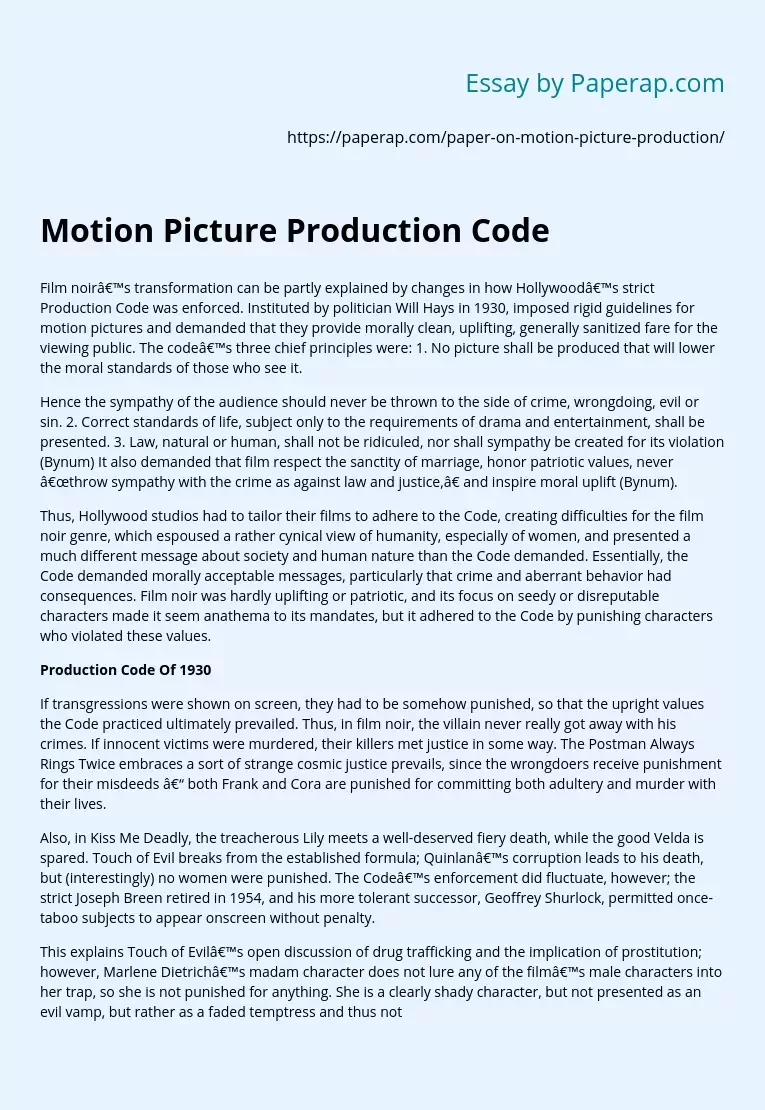Motion Picture Production Code
Film noir’s transformation can be partly explained by changes in how Hollywood’s strict Production Code was enforced. Instituted by politician Will Hays in 1930, imposed rigid guidelines for motion pictures and demanded that they provide morally clean, uplifting, generally sanitized fare for the viewing public. The code’s three chief principles were: 1. No picture shall be produced that will lower the moral standards of those who see it.
Hence the sympathy of the audience should never be thrown to the side of crime, wrongdoing, evil or sin.
2. Correct standards of life, subject only to the requirements of drama and entertainment, shall be presented. 3. Law, natural or human, shall not be ridiculed, nor shall sympathy be created for its violation (Bynum) It also demanded that film respect the sanctity of marriage, honor patriotic values, never “throw sympathy with the crime as against law and justice,” and inspire moral uplift (Bynum).
Thus, Hollywood studios had to tailor their films to adhere to the Code, creating difficulties for the film noir genre, which espoused a rather cynical view of humanity, especially of women, and presented a much different message about society and human nature than the Code demanded.
Essentially, the Code demanded morally acceptable messages, particularly that crime and aberrant behavior had consequences. Film noir was hardly uplifting or patriotic, and its focus on seedy or disreputable characters made it seem anathema to its mandates, but it adhered to the Code by punishing characters who violated these values.
Production Code Of 1930
If transgressions were shown on screen, they had to be somehow punished, so that the upright values the Code practiced ultimately prevailed.
Thus, in film noir, the villain never really got away with his crimes. If innocent victims were murdered, their killers met justice in some way. The Postman Always Rings Twice embraces a sort of strange cosmic justice prevails, since the wrongdoers receive punishment for their misdeeds – both Frank and Cora are punished for committing both adultery and murder with their lives.
Also, in Kiss Me Deadly, the treacherous Lily meets a well-deserved fiery death, while the good Velda is spared. Touch of Evil breaks from the established formula; Quinlan’s corruption leads to his death, but (interestingly) no women were punished. The Code’s enforcement did fluctuate, however; the strict Joseph Breen retired in 1954, and his more tolerant successor, Geoffrey Shurlock, permitted once-taboo subjects to appear onscreen without penalty.
This explains Touch of Evil’s open discussion of drug trafficking and the implication of prostitution; however, Marlene Dietrich’s madam character does not lure any of the film’s male characters into her trap, so she is not punished for anything. She is a clearly shady character, but not presented as an evil vamp, but rather as a faded temptress and thus not genuinely dangerous. Essentially, female characters got what they deserved, though the scope of what they were allowed to do had broadened.
Women in film noir reflected changes not only in Hollywood’s production codes but also in American morality and gender roles. The earliest films in that genre reflected America’s stricter expectations of women and a more straitlaced moral standard; women who violated those were intriguing to watch onscreen, but only if they received punishment for breaking taboos. As time progressed and moral standards loosened, film noir’s women were less likely to fit rigid archetypes or receive punishment for activities that no longer seemed quite as shocking.
The film noir woman thus reflected changes in American morality and views of women, which relaxed as women’s sexuality was gradually better understood and accepted.
BIBLIOGRAPHY
Bynum, Matt. “The Motion Picture Production Code of 1930 (Hays Code). ” Arts Reformation. 2006. <http://www. artsreformation. com/a001/hays-code. html>. Christopher, Nicholas. Somewhere in the Night. New York: Free Press, 1997. Doane, Mary Ann. Femmes Fatales. New York: Routledge, 1991. Kiss Me Deadly. Dir. Robert Aldrich. Perf. Ralph Meeker, Albert Dekker, Maxine Cooper, and Gaby Rodgers. United Artists, 1955.
Motion Picture Production Code. (2019, Dec 05). Retrieved from https://paperap.com/paper-on-motion-picture-production/

